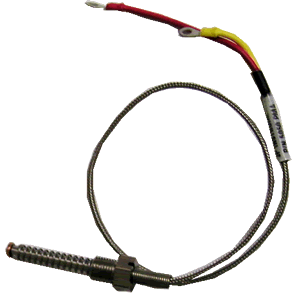 A CHT Bayonet probe is a threaded probe typically used on Lycoming engines in aircraft. These spring-loaded bayonet mounted CHT probes are usually ‘K’-type probes and they generally include an adopter.
A CHT Bayonet probe is a threaded probe typically used on Lycoming engines in aircraft. These spring-loaded bayonet mounted CHT probes are usually ‘K’-type probes and they generally include an adopter.
The CHT Bayonet probe are turned clock-wise and locked into the screw-in adapter and screwed into the cylinder head thermo well. Being spring-loaded, the probe has good contact with the metal of the cylinder. The k-probe is used when the aircraft engine has a bayonet adapter in the cylinders. It can also be used if the cylinder is equipped with threaded thermowell receptor.
CHT Bayonet probes are generally K-type because they have a wider temperature sensitivity. This is typically in the range of -200°C to +1250°C (-330°F to +2460°F). The sensitivity is approximately 41 µV/°C. Most CDT Probes and EGT probes used in aircraft are of the K-type and the sensor is an amalgam of Alumel and Chromel – two metals that react differently but very precisely.
Typically, CHT Bayonet probes come in two flavours; non-grounded and grounded. The non-grounded probes have the thermocouple junction isolated from the probe shaft. This is done to ensure that there is no continuity between the thermocouple.
The grounded probes are just the opposite in that they have the thermocouple junction welded directly to the probe shaft. This results in a probe that has longer life, lower cost and faster response time. However, these grounded probes suffer from one disadvantage - they are susceptible to electrical noise which, unless rectified via special circuit in the Aircraft Engine Gauges, could result in temperature readings that are slightly off the mark.
The CHT Bayonet probe is easily installed:
1. You begin by screwing in the threaded CHT probes into the cylinders.
2. For 4-cylinder aircraft engine, thermocouple channels TC5 through TC8 are used. For 6-cylinder aircraft engine, thermocouple channels TC7 through TC12 are used.
3. In K-type thermocouples, yellow is positive and red is negative.
If you find that the wiring does not reach the cylinders, you can obtain CHT extension kits with k-type thermocouple wire, splice barrels, and a length of inner heat shrink tubing. Using heat shrink tubing eliminates all air inside the splice and makes an airtight seal. We recommend Raychem SCL-3/16 heat shrink tubing.
Extending the wires of CHT Bayonet probe in aircraft:
1. Using a wire stripper, strip the CHTs and make small loops with the ends; do the same for the k-type extension wire (if used).
2. Prepare the splice barrels.
3. Use the splice barrel and short length of shrink wrap on the wires.
4. Lay the CHT and k-type extension loops over each other.
5. Slide the splice barrel over the parallel loops.
6. Crimp the splice barrel with a crimping tool.
7. Slide the heat shrink over the splice and apply heat to the extent required so the heat shrink tube properly grips the joint.
8. You now have an airtight, solder-free and airless parallel thermocouple splice.
Visit here for more information:- https://www.jpinstruments.com/shop/cht-bayonet-probe/

